Ziyu Zhu
From Objects to Anywhere: A Holistic Benchmark for Multi-level Visual Grounding in 3D Scenes
Jun 05, 2025Abstract:3D visual grounding has made notable progress in localizing objects within complex 3D scenes. However, grounding referring expressions beyond objects in 3D scenes remains unexplored. In this paper, we introduce Anywhere3D-Bench, a holistic 3D visual grounding benchmark consisting of 2,632 referring expression-3D bounding box pairs spanning four different grounding levels: human-activity areas, unoccupied space beyond objects, objects in the scene, and fine-grained object parts. We assess a range of state-of-the-art 3D visual grounding methods alongside large language models (LLMs) and multimodal LLMs (MLLMs) on Anywhere3D-Bench. Experimental results reveal that space-level and part-level visual grounding pose the greatest challenges: space-level tasks require a more comprehensive spatial reasoning ability, for example, modeling distances and spatial relations within 3D space, while part-level tasks demand fine-grained perception of object composition. Even the best performance model, OpenAI o4-mini, achieves only 23.57% accuracy on space-level tasks and 33.94% on part-level tasks, significantly lower than its performance on area-level and object-level tasks. These findings underscore a critical gap in current models' capacity to understand and reason about 3D scene beyond object-level semantics.
DexGarmentLab: Dexterous Garment Manipulation Environment with Generalizable Policy
May 19, 2025Abstract:Garment manipulation is a critical challenge due to the diversity in garment categories, geometries, and deformations. Despite this, humans can effortlessly handle garments, thanks to the dexterity of our hands. However, existing research in the field has struggled to replicate this level of dexterity, primarily hindered by the lack of realistic simulations of dexterous garment manipulation. Therefore, we propose DexGarmentLab, the first environment specifically designed for dexterous (especially bimanual) garment manipulation, which features large-scale high-quality 3D assets for 15 task scenarios, and refines simulation techniques tailored for garment modeling to reduce the sim-to-real gap. Previous data collection typically relies on teleoperation or training expert reinforcement learning (RL) policies, which are labor-intensive and inefficient. In this paper, we leverage garment structural correspondence to automatically generate a dataset with diverse trajectories using only a single expert demonstration, significantly reducing manual intervention. However, even extensive demonstrations cannot cover the infinite states of garments, which necessitates the exploration of new algorithms. To improve generalization across diverse garment shapes and deformations, we propose a Hierarchical gArment-manipuLation pOlicy (HALO). It first identifies transferable affordance points to accurately locate the manipulation area, then generates generalizable trajectories to complete the task. Through extensive experiments and detailed analysis of our method and baseline, we demonstrate that HALO consistently outperforms existing methods, successfully generalizing to previously unseen instances even with significant variations in shape and deformation where others fail. Our project page is available at: https://wayrise.github.io/DexGarmentLab/.
Seed1.5-VL Technical Report
May 11, 2025Abstract:We present Seed1.5-VL, a vision-language foundation model designed to advance general-purpose multimodal understanding and reasoning. Seed1.5-VL is composed with a 532M-parameter vision encoder and a Mixture-of-Experts (MoE) LLM of 20B active parameters. Despite its relatively compact architecture, it delivers strong performance across a wide spectrum of public VLM benchmarks and internal evaluation suites, achieving the state-of-the-art performance on 38 out of 60 public benchmarks. Moreover, in agent-centric tasks such as GUI control and gameplay, Seed1.5-VL outperforms leading multimodal systems, including OpenAI CUA and Claude 3.7. Beyond visual and video understanding, it also demonstrates strong reasoning abilities, making it particularly effective for multimodal reasoning challenges such as visual puzzles. We believe these capabilities will empower broader applications across diverse tasks. In this report, we mainly provide a comprehensive review of our experiences in building Seed1.5-VL across model design, data construction, and training at various stages, hoping that this report can inspire further research. Seed1.5-VL is now accessible at https://www.volcengine.com/ (Volcano Engine Model ID: doubao-1-5-thinking-vision-pro-250428)
Masked Point-Entity Contrast for Open-Vocabulary 3D Scene Understanding
Apr 28, 2025Abstract:Open-vocabulary 3D scene understanding is pivotal for enhancing physical intelligence, as it enables embodied agents to interpret and interact dynamically within real-world environments. This paper introduces MPEC, a novel Masked Point-Entity Contrastive learning method for open-vocabulary 3D semantic segmentation that leverages both 3D entity-language alignment and point-entity consistency across different point cloud views to foster entity-specific feature representations. Our method improves semantic discrimination and enhances the differentiation of unique instances, achieving state-of-the-art results on ScanNet for open-vocabulary 3D semantic segmentation and demonstrating superior zero-shot scene understanding capabilities. Extensive fine-tuning experiments on 8 datasets, spanning from low-level perception to high-level reasoning tasks, showcase the potential of learned 3D features, driving consistent performance gains across varied 3D scene understanding tasks. Project website: https://mpec-3d.github.io/
Unveiling the Mist over 3D Vision-Language Understanding: Object-centric Evaluation with Chain-of-Analysis
Apr 01, 2025Abstract:Existing 3D vision-language (3D-VL) benchmarks fall short in evaluating 3D-VL models, creating a "mist" that obscures rigorous insights into model capabilities and 3D-VL tasks. This mist persists due to three key limitations. First, flawed test data, like ambiguous referential text in the grounding task, can yield incorrect and unreliable test results. Second, oversimplified metrics such as simply averaging accuracy per question answering (QA) pair, cannot reveal true model capability due to their vulnerability to language variations. Third, existing benchmarks isolate the grounding and QA tasks, disregarding the underlying coherence that QA should be based on solid grounding capabilities. To unveil the "mist", we propose Beacon3D, a benchmark for 3D-VL grounding and QA tasks, delivering a perspective shift in the evaluation of 3D-VL understanding. Beacon3D features (i) high-quality test data with precise and natural language, (ii) object-centric evaluation with multiple tests per object to ensure robustness, and (iii) a novel chain-of-analysis paradigm to address language robustness and model performance coherence across grounding and QA. Our evaluation of state-of-the-art 3D-VL models on Beacon3D reveals that (i) object-centric evaluation elicits true model performance and particularly weak generalization in QA; (ii) grounding-QA coherence remains fragile in current 3D-VL models, and (iii) incorporating large language models (LLMs) to 3D-VL models, though as a prevalent practice, hinders grounding capabilities and has yet to elevate QA capabilities. We hope Beacon3D and our comprehensive analysis could benefit the 3D-VL community towards faithful developments.
GarmentPile: Point-Level Visual Affordance Guided Retrieval and Adaptation for Cluttered Garments Manipulation
Mar 12, 2025Abstract:Cluttered garments manipulation poses significant challenges due to the complex, deformable nature of garments and intricate garment relations. Unlike single-garment manipulation, cluttered scenarios require managing complex garment entanglements and interactions, while maintaining garment cleanliness and manipulation stability. To address these demands, we propose to learn point-level affordance, the dense representation modeling the complex space and multi-modal manipulation candidates, while being aware of garment geometry, structure, and inter-object relations. Additionally, as it is difficult to directly retrieve a garment in some extremely entangled clutters, we introduce an adaptation module, guided by learned affordance, to reorganize highly-entangled garments into states plausible for manipulation. Our framework demonstrates effectiveness over environments featuring diverse garment types and pile configurations in both simulation and the real world. Project page: https://garmentpile.github.io/.
On Domain-Specific Post-Training for Multimodal Large Language Models
Nov 29, 2024
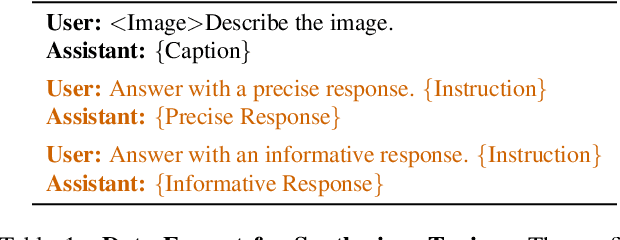
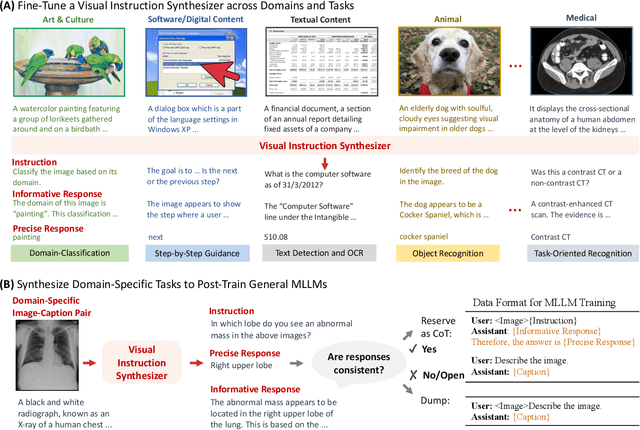

Abstract:Recent years have witnessed the rapid development of general multimodal large language models (MLLMs). However, adapting general MLLMs to specific domains, such as scientific fields and industrial applications, remains less explored. This paper systematically investigates domain adaptation of MLLMs through post-training, focusing on data synthesis, training pipelines, and task evaluation. (1) Data Synthesis: Using open-source models, we develop a visual instruction synthesizer that effectively generates diverse visual instruction tasks from domain-specific image-caption pairs. Our synthetic tasks surpass those generated by manual rules, GPT-4, and GPT-4V in enhancing the domain-specific performance of MLLMs. (2) Training Pipeline: While the two-stage training--initially on image-caption pairs followed by visual instruction tasks--is commonly adopted for developing general MLLMs, we apply a single-stage training pipeline to enhance task diversity for domain-specific post-training. (3) Task Evaluation: We conduct experiments in two domains, biomedicine and food, by post-training MLLMs of different sources and scales (e.g., Qwen2-VL-2B, LLaVA-v1.6-8B, Llama-3.2-11B), and then evaluating MLLM performance on various domain-specific tasks. To support further research in MLLM domain adaptation, we will open-source our implementations.
GarmentLab: A Unified Simulation and Benchmark for Garment Manipulation
Nov 02, 2024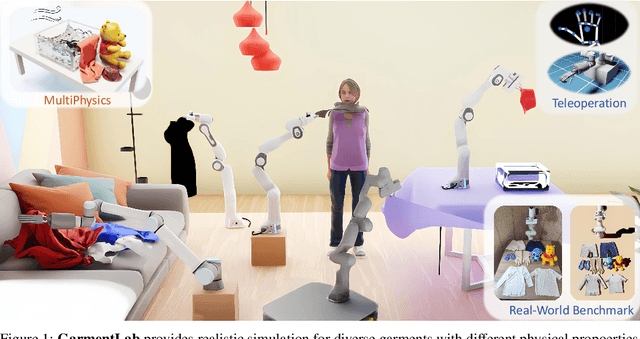

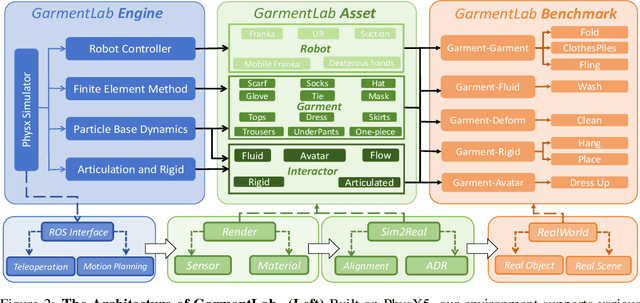

Abstract:Manipulating garments and fabrics has long been a critical endeavor in the development of home-assistant robots. However, due to complex dynamics and topological structures, garment manipulations pose significant challenges. Recent successes in reinforcement learning and vision-based methods offer promising avenues for learning garment manipulation. Nevertheless, these approaches are severely constrained by current benchmarks, which offer limited diversity of tasks and unrealistic simulation behavior. Therefore, we present GarmentLab, a content-rich benchmark and realistic simulation designed for deformable object and garment manipulation. Our benchmark encompasses a diverse range of garment types, robotic systems and manipulators. The abundant tasks in the benchmark further explores of the interactions between garments, deformable objects, rigid bodies, fluids, and human body. Moreover, by incorporating multiple simulation methods such as FEM and PBD, along with our proposed sim-to-real algorithms and real-world benchmark, we aim to significantly narrow the sim-to-real gap. We evaluate state-of-the-art vision methods, reinforcement learning, and imitation learning approaches on these tasks, highlighting the challenges faced by current algorithms, notably their limited generalization capabilities. Our proposed open-source environments and comprehensive analysis show promising boost to future research in garment manipulation by unlocking the full potential of these methods. We guarantee that we will open-source our code as soon as possible. You can watch the videos in supplementary files to learn more about the details of our work. Our project page is available at: https://garmentlab.github.io/
Task-oriented Sequential Grounding in 3D Scenes
Aug 07, 2024
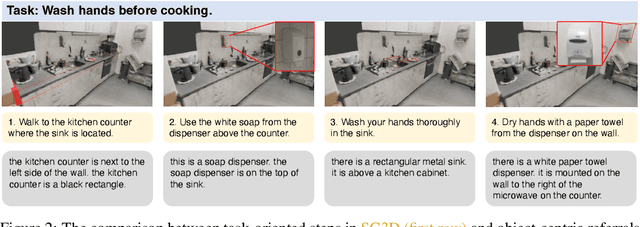

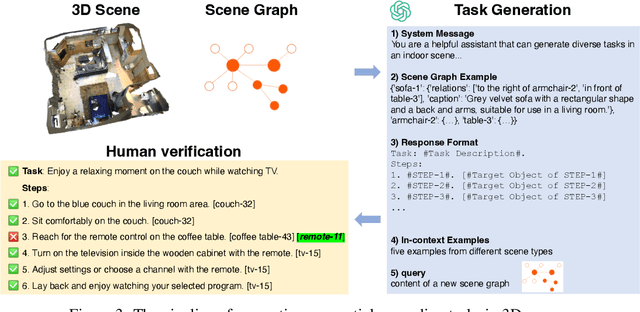
Abstract:Grounding natural language in physical 3D environments is essential for the advancement of embodied artificial intelligence. Current datasets and models for 3D visual grounding predominantly focus on identifying and localizing objects from static, object-centric descriptions. These approaches do not adequately address the dynamic and sequential nature of task-oriented grounding necessary for practical applications. In this work, we propose a new task: Task-oriented Sequential Grounding in 3D scenes, wherein an agent must follow detailed step-by-step instructions to complete daily activities by locating a sequence of target objects in indoor scenes. To facilitate this task, we introduce SG3D, a large-scale dataset containing 22,346 tasks with 112,236 steps across 4,895 real-world 3D scenes. The dataset is constructed using a combination of RGB-D scans from various 3D scene datasets and an automated task generation pipeline, followed by human verification for quality assurance. We adapted three state-of-the-art 3D visual grounding models to the sequential grounding task and evaluated their performance on SG3D. Our results reveal that while these models perform well on traditional benchmarks, they face significant challenges with task-oriented sequential grounding, underscoring the need for further research in this area.
Unifying 3D Vision-Language Understanding via Promptable Queries
May 19, 2024



Abstract:A unified model for 3D vision-language (3D-VL) understanding is expected to take various scene representations and perform a wide range of tasks in a 3D scene. However, a considerable gap exists between existing methods and such a unified model, due to the independent application of representation and insufficient exploration of 3D multi-task training. In this paper, we introduce PQ3D, a unified model capable of using Promptable Queries to tackle a wide range of 3D-VL tasks, from low-level instance segmentation to high-level reasoning and planning. This is achieved through three key innovations: (1) unifying various 3D scene representations (i.e., voxels, point clouds, multi-view images) into a shared 3D coordinate space by segment-level grouping, (2) an attention-based query decoder for task-specific information retrieval guided by prompts, and (3) universal output heads for different tasks to support multi-task training. Tested across ten diverse 3D-VL datasets, PQ3D demonstrates impressive performance on these tasks, setting new records on most benchmarks. Particularly, PQ3D improves the state-of-the-art on ScanNet200 by 1.8% (AP), ScanRefer by 5.4% (acc@0.5), Multi3DRefer by 11.7% (F1@0.5), and Scan2Cap by 13.4% (CIDEr@0.5). Moreover, PQ3D supports flexible inference with individual or combined forms of available 3D representations, e.g., solely voxel input.
 Add to Chrome
Add to Chrome Add to Firefox
Add to Firefox Add to Edge
Add to Edge